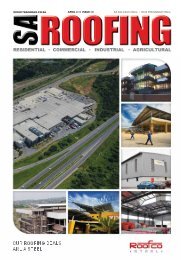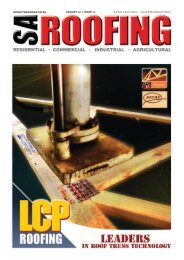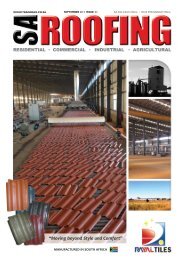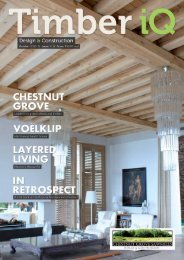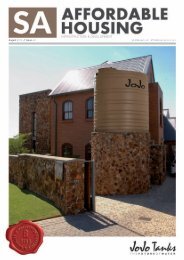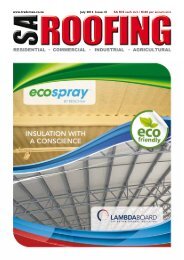project - Trademax Publications
project - Trademax Publications
project - Trademax Publications
Create successful ePaper yourself
Turn your PDF publications into a flip-book with our unique Google optimized e-Paper software.
concrete<br />
Concrete’s vital<br />
sustainable role now<br />
recognised<br />
Appreciating the sustainability of concrete as a building material is proving to be<br />
increasingly important as the global concern about environmental preservation<br />
continues, according to Daniel van der Merwe, architect at the<br />
Cement & Concrete Institute (C&CI).<br />
Van der Merwe says although concrete is the most<br />
commonly used building material in the world, much<br />
of what it can offer as a sustainable material is<br />
overlooked.<br />
“Materials specification must play a critical role to reduce<br />
the embodied energy in a building. Materials manufacture<br />
also needs to be factored in terms of measurable emissions,<br />
energy and finite material consumption. Buildings must now be<br />
constructed with a longer lifespan in mind, with the emphasis<br />
on durability and retrofitting rather than demolition,” he states.<br />
Van der Merwe says the cement and concrete industry has<br />
committed itself to responsible manufacturing. It has managed<br />
to boost production while decreasing the use of raw finite<br />
materials, while the use of cement extenders has significantly<br />
reduced the clinker portion<br />
in certain cement products.<br />
“Cement producers have already<br />
reached 50% of the set target of<br />
the Department of Minerals and<br />
Energy which calls for a 15%<br />
reduction of energy consumption<br />
by 2015. Through the use of<br />
alternative fuels and resources –<br />
including hazardous waste and<br />
scrapped tyres – as a fuel source,<br />
further reductions are possible.”<br />
“New permeable concrete pavers, soil erosion blocks and<br />
embankment stabilising blocks save water and prevent storm<br />
water run-offs and flooding; and self-compacting concrete in<br />
sustainable developments allows for architectural achievements<br />
previously regarded as impossible.<br />
“Moreover, new research is producing exciting data on the reabsorption<br />
of carbon dioxide by hardened concrete.<br />
A Danish study has found that 50% of the volume of concrete<br />
will be ‘carbonated’ over 70 years of any building’s service<br />
life.<br />
This sponge effect makes concrete a more green choice than<br />
previously thought. And it emphasises how global sustainability<br />
can be achieved with concrete,” van der Merwe added.<br />
The fitting of bag house filters, or<br />
electrostatic precipitators, is further<br />
reducing particulate emissions;<br />
and chemical admixtures are<br />
helping to reduce the cement and<br />
water content in concrete mixes.<br />
Through lightweight void form<br />
precast hollow-core slabs, the<br />
volume of in-situ concrete is also<br />
being substantially reduced.<br />
Concrete buildings offer unparalleled durability, says the C&CI<br />
45<br />
SA Affordable Housing November/December 2009




